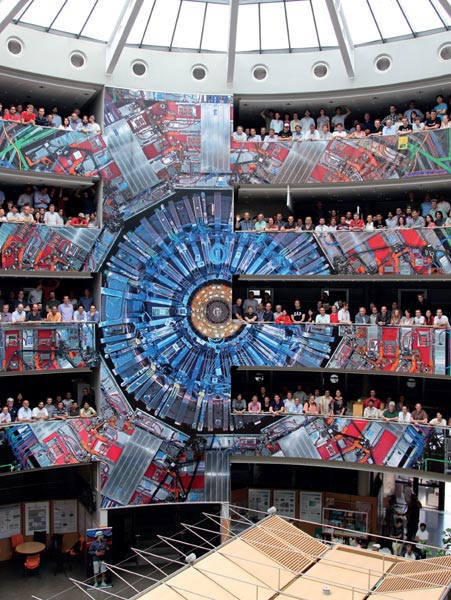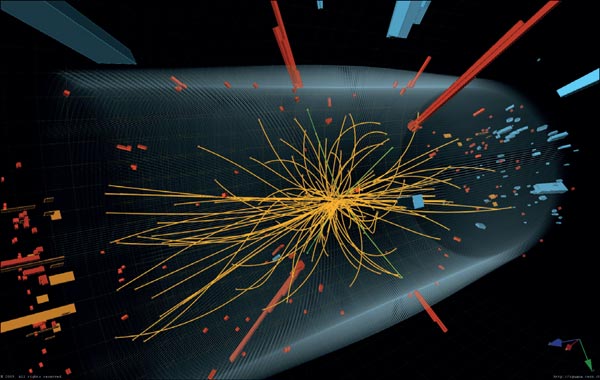A management model for running large collaborations.

Image credit: Achintya Rao.
New members of the top-level management talk to Antonella Del Rosso about the CMS model for running a large collaboration, as they prepare for the start of the LHC’s run in 2012.

Trying to uncover the deepest mysteries of the universe is no trivial task. Today, the scientific collaborations that accept the challenge are huge, complex organizational structures that have their own constitution, strict budget control and top management. CMS, one of two general-purpose experiments that study the LHC collisions, provides a good example of how this type of scientific complexity can be dealt with.
The collaboration has literally thousands of heroes
Tiziano Camporesi
The CMS collaboration currently has around 4300 members, with more than 1000 new faces joining in the past three years. Together they come from some 170 institutes in 40 countries and six continents. Each institute has specific tasks to complete, which are agreed with the management leading the collaboration. “The collaboration is evolving all of the time. Every year we receive applications from five or so new institutes that wish to participate in the experiment,” says Joe Incandela of the University of California Santa Barbara and CERN, who took over as spokesperson of the CMS collaboration at the start of 2012. “The Collaboration Board has the task of considering those applications and taking a decision after following the procedures described in the CMS constitution. All of the participating institutes are committed to maintaining, operating, upgrading and exploiting the physics of the detector.”
Once they become full members of the collaboration, all institutes are represented on the Collaboration Board – the true governing body of CMS. (In practice, small institutes join together and choose a common representative.) The representatives can also vote for the spokesperson every two years. “To manage such a complex structure that must achieve very ambitious goals, the collaboration has so far always sought a spokesperson from among those people who have contributed to the experiment in some substantial way over the years and who have demonstrated some managerial and leadership qualities,” notes deputy-spokesperson Tiziano Camporesi of CERN . “We often meet film-makers or journalists who tell us that they want to feature a few people. They want to have ‘stars’ who can be the heroes of the show but we always tell them that the collaboration has literally thousands of heroes. I have often heard it said that we are like an orchestra: the conductor is important but the whole thing only works if every single musician plays well.”
Although two years may seem to be a short term, Joao Varela – who is a professor at the Instituto Superior Técnico of the Technical University of Lisbon and also deputy-spokesperson – believes that there are many positive aspects in changing the top management rather frequently. “The ‘two-years scheme’ allows CMS to grant this prestigious role to more people over time,” he says. “In this way, more institutes and cultures can be represented at such a high level. There is a sense of fairness in the honour being shared across the whole community. Moreover, each time a new person comes in, by human nature he/she is motivated to bring in new ideas.”
As good as the idea is to rotate people in the top management, the CMS collaboration is currently analysing the experience already accumulated to see if things can be improved. “So far deputies have always been elected as spokespersons and this has ensured continuity even during the short overlap. I was myself in physics co-ordination, then deputy and finally spokesperson. Even so, I am learning many new things every day,” points out Incandela.
At CMS the spokesperson also nominates his/her deputies and many of the members of the Executive Board, which brings together project managers and activity co-ordinators. “The members of the Executive Board are responsible for most of the day-to-day co-ordination work that is a big part of what makes CMS work so well,” explains Incandela. “Each member is responsible for managing an organization with large numbers of people and a considerable budget in some cases. Historically, the different projects and activities were somewhat isolated from one another, so that members of the board didn’t really have a chance or need to follow what the other areas were doing. With the start of LHC operations in 2008 this began to change and now people focus on broader issues.” To improve communication among the members of the Executive Board, the new CMS management also decided to organize workshops. “These have turned out to be fantastic events,” says Camporesi. “At the meetings, we discuss important and broad issues openly, from what is the best way to do great physics to how to maintain high morale and attract excellent young people to the collaboration.”
To keep the whole collaboration informed about the outcomes of such strategic meetings and other developments in the experiment in general, the CMS management organizes weekly plenary meetings. “I report once a week to the whole collaboration: we typically have anywhere from 50 to 250 people attending, plus 100–200 remote connections. We are a massive organization and the weekly update is a quick and useful means of keeping everybody informed,” adds Incandela.
The scientific achievements of CMS prove not only that a large scientific collaboration is manageable but also that it is effective. In January this year a new two-year term began for the CMS collaboration, which also renewed all of the members of top management. This is a historic moment for the experiment because many potential discoveries are in the pipeline. “This is my third generation of hadron collider – I participated in the UA2 experiment at CERN’s SPS, CDF at Fermilab’s Tevatron and now CMS at the LHC. When you are proposing a new experiment and then building it, the focus is entirely on the detector,” observes Incandela. “Then, when the beam comes, attention moves rapidly to the data and physics. The collaboration is mainly interested in data and the discoveries that we hope to make. We must ensure the high performance of the detector while providing the means for extremely accurate but quick data analysis. However, although almost everything works perfectly, there are already many small things in the detector that need repairing and upgrading.”
It is obviously important if we discover things. But is also important if we don’t see anything
Joao Valera
The accelerator settings for the LHC’s 2012 run, decided at the Chamonix Workshop in February, will mean that CMS has to operate in conditions that go beyond the design target. “The detector will face tougher pile-up conditions and our teams of experts have been working hard to ensure that all of the subsystems work as expected. It looks like the detector can cope with conditions that are up to 50% higher than the design target”, confirms Camporesi. “Going beyond that could create serious issues for the experiment. We observe that the Level1 trigger starts to be a limitation and the pixel detector starts to lose data, for instance.” CMS is already planning upgrades to improve granularity and trigger performance to cope with the projected higher luminosity beyond 2014.
Going to higher luminosity may be a big technical challenge but it does mean reducing the times to discoveries. “The final word on the Higgs boson is within reach, now measurable in terms of months rather than years. And for supersymmetry, we are changing the strategy. In 2010–2011, we were essentially searching for supersymmetric partners of light quarks because they were potentially more easily accessible. This approach didn’t yield any fruit but put significant constraints on popular models. A lot of people were discouraged,” explains Varela. “However, what we have not ruled out are possible relatively light supersymmetric partners of the third-generation quarks. The third generation is a tougher thing to look for because the signal is smaller and the backgrounds can be higher. By increasing the energy of the collisions to 4 TeV one gains 50–70% in pair production of supersymmetric top, for instance, while the top-pair background rises by a smaller margin. Having said this, and given the unexplored environment, it is obviously important if we discover things. But it is also important if we don’t see anything.”
There is a long road ahead because the searches will continue at higher LHC energies and luminosities after 2014, but the CMS collaboration plans to be well prepared.







